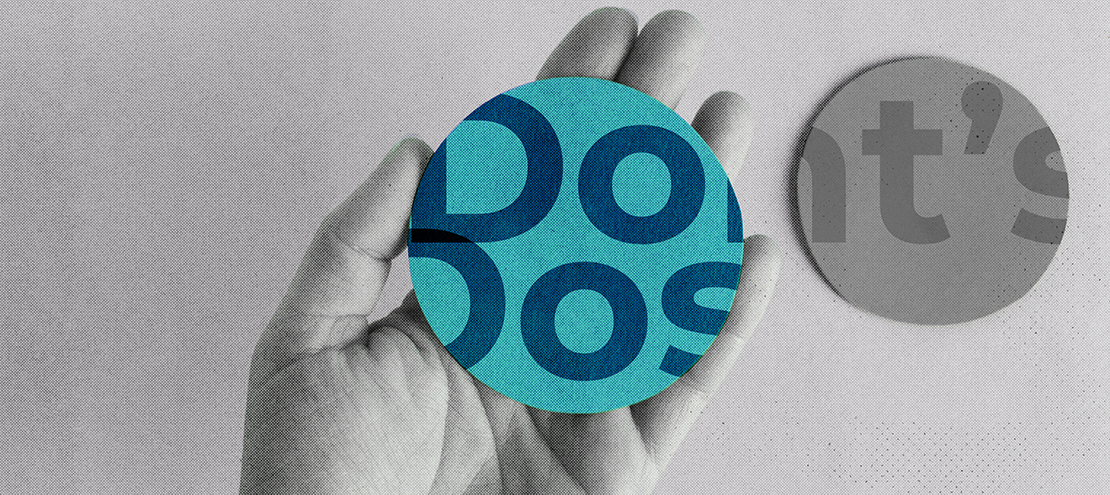
Every advertiser hopes that a marketing campaign will go viral, and what’s more viral than memes? But there’s a right and wrong way to leverage memes when speaking on behalf of a brand. By following these dos and don’ts, you can have some fun with existing customers while appealing to a much broader audience.
Do: Align memes with your brand voice
Memes may be jokes the entire internet laughs along with, but they still need to reflect your brand values. If one of your core traits is positivity, funny yet nihilistic memes probably aren’t going to land the way you expect. On the other hand, self-awareness of how jokes reflect your brand can help your audience grow.

This example is not theoretical. When Arby’s realized it was the subject of a parody Twitter account called “Nihilistic Arby’s,” it knew responding in kind conflict with its laid-back persona. Instead, it flew an executive out to bring food and an adorable puppy to the account creator. The result of this kill-them-with-kindness strategy was more goodwill for Arby’s that subverted the memes without dismissing them outright.

Do: Know your audience
Contrary to popular opinion, memes don’t translate universally to all online audiences. Instead, they spread through internet cultures that are familiar with the reference point. Memes are rooted in language conventions and shared understandings that trigger a response to share them. This behavior is precisely why some of the biggest memes tend to revolve around movies and TV shows in the popular zeitgeist — it makes us all feel like Captain America in the Avengers.

Marketers are already familiar with this concept, as it applies to every marketing campaign. Knowing your core audience is the quickest way to determine what messaging will resonate or which deals will convince them to make a purchase. For a brand-made meme to take off, that same understanding of online culture is crucial.
So, if your audience is millennials who love to talk about movies on social media, memes based on pop culture might strike the right tone. If they’re more academic, jokes about higher learning in 2020 may go farther than you think, including this one created by Western University instructor Yimin Chen.

Don’t: Chase trending memes because they’re trending
Memes are sharable, so when a marketer sees one going viral in real-time, it’s tempting to chase the trend with your own hasty contribution. Please. Do. Not. Do. This. As a marketer, your role is not to force branded messaging into any popular meme. Instead, filter through them to find the one that will have the greatest impact.
Still, you might wonder what the harm is, considering anyone can produce memes at literally no cost. Why not leverage that freedom to drive more views for your brand? Unfortunately, not all attention is good attention, and misreading a trending meme can ensure the focus is negative. BMW learned this the hard way when it latched onto the “OK Boomer” hashtag, not realizing the meme is dismissive of boomers — a significant portion of their audience.

That’s not to say marketers should ignore meme trends or only use the most inoffensive examples. The issue is when marketers don’t understand the origins or cultural insensitivity of a given phrase. Pay attention to what will resonate with different audiences and internet subcultures, and you can be more than the punchline of a hashtag.
Don’t: Overdo it
Memes can be valuable marketing tools, but they are not always effective marketing tools. Yes, they drive brand awareness, but they are exclusively top of funnel content. Spending too much time on memes may inflate your social media following, but it won’t necessarily drive conversions if you don’t balance it out with messaging and lead generation techniques.
On top of this challenge, becoming too reliant on memes can backfire horribly. Wendy’s and Denny’s both became popular for edgy posts with viral appeal, but on occasion, they became overconfident about whether a joke would land. Denny’s ended up in hot water when a meme made light of waitress tipping — which was in poor taste given Denny’s low wages. Social media goodwill is fickle, so focus on a few good memes and move on.

Do: Experiment with meme formats and challenges
We often treat memes as a catch-all term for funny pictures shared on social media, but that’s only part of the story. At their core, memes are simply a process of mimicking and remixing concepts — taking something recognizable and putting a unique spin on it.
This detail is essential because by that definition, memes don’t have to be limited to images. These formats are evolving alongside internet culture, and marketers who wish to use memes effectively have countless opportunities at their disposal. Outside of still images, other examples of popular memes include:
- GIFs
- Reshares of social media posts
- Hashtags
- Short videos
If you’re looking for an excellent place to start, be on the lookout for meme challenges. These viral events take a simple, broadly applicable meme and put a personal spin on the concept.
Some recent examples include 2020 mood boards and how it started and ended comparisons, both of which drove impressive turnout from brands. Meme challenges have a short shelf life, but they’re an excellent platform for experimentation.
Of course, you’ll still need to follow the advice above — a meme challenge can go badly if you neglect your brand voice or audience expectations. But memes are a fixture of online culture and can benefit your long-term marketing strategy if you leverage them effectively.
Become the best CRMer you can:
CRM Hack: measuring the right marketing campaign KPIs
How To: use loyalty data to power retention and reactivation
See how brands take their email deliverability to the max
Get inspired: great sports betting campaigns to follow
The post The Dos and Don’ts of Meme-Based Marketing appeared first on Post Funnel.



